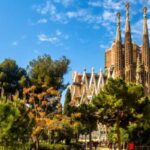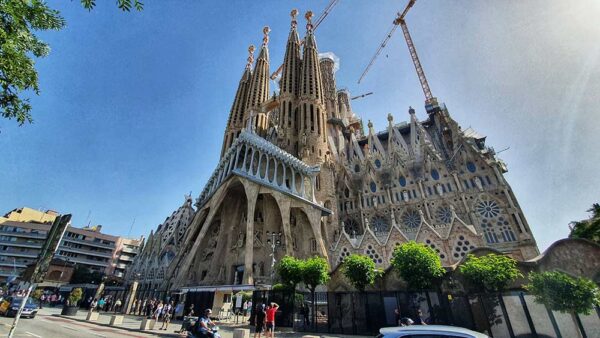
The Sagrada Familia in Barcelona is not just a stunning piece of architecture; it is a symbol of the city itself, embodying its rich history and cultural significance. Designed by the visionary architect Antoni Gaudí, this iconic basilica has been under construction since 1882, captivating millions with its intricate details and unique style.
In this article, we will explore The Fascinating History of Barcelona's Sagrada Familia: A Brief Overview, delving into the challenges faced during its construction, the innovative techniques employed by Gaudí, and the ongoing efforts to complete this masterpiece. Join us on a journey through time to discover the story behind one of the most beloved landmarks in the world.
The Architectural Significance of the Sagrada Familia in Barcelona
The architectural significance of the Sagrada Familia lies in its unique blend of Gothic and Art Nouveau styles, creating a visual language that is both innovative and deeply rooted in tradition. Gaudí's use of organic forms and natural motifs allows the basilica to harmonize with its surroundings, making it a true reflection of Barcelona's vibrant identity. This approach not only enhances the aesthetic appeal but also serves a functional purpose, as the structure is designed to withstand the test of time.
One of the most striking features of the Sagrada Familia is its intricate façade. The Nativity and Passion façades offer a stunning contrast, showcasing Gaudí's ability to convey different emotional tones through architecture. The use of light and shadow plays a crucial role in the overall experience, as visitors move through the space and witness how the changing daylight influences the atmosphere inside.
- Innovative Engineering: Gaudí implemented techniques like hyperboloid structures and catenary arches, which distribute weight more effectively.
- Symbolism: Each element of the Sagrada Familia serves a purpose, often representing Christian themes and natural elements.
- Natural Light: The basilica's design incorporates stained glass windows that filter light, creating an ethereal experience for worshippers and tourists alike.
In summary, the Sagrada Familia stands as a testament to Gaudí's genius and vision, merging art and architecture in a way that continues to inspire and captivate. Its ongoing construction reflects not only a commitment to preserving this masterpiece but also a dedication to pushing the boundaries of architectural design, ensuring that it remains a vital part of Barcelona's cultural landscape for generations to come.
Exploring the Unique Design Elements of Antoni Gaudí's Masterpiece
Antoni Gaudí's Sagrada Familia is renowned for its distinctive design elements that set it apart from traditional basilicas. One of the most notable features is the use of natural forms, inspired by the shapes and structures found in nature. Gaudí believed that nature was a perfect model, and he incorporated this philosophy into the basilica's columns, which resemble tree trunks branching out to support the ceiling, creating a forest-like atmosphere within.
Another unique aspect of the Sagrada Familia is its asymmetrical design. Unlike conventional churches with uniform shapes, Gaudí adopted a dynamic approach, allowing each façade and tower to tell its own story. This intentional irregularity enhances the basilica's overall visual impact and invites viewers to appreciate the evolving perspective as they move around the structure.
- Colorful Stained Glass: The use of vibrant stained glass windows creates a play of colors that transform the interior into a spiritual experience, reflecting the changing light throughout the day.
- Symbolic Geometry: Gaudí employed complex geometrical shapes, such as hyperboloids and paraboloids, to symbolize the harmony between the earthly and the divine.
- Nature-Inspired Details: Elements like the organic motifs found in sculptures and carvings evoke the flora and fauna of the Mediterranean, further bridging the connection between architecture and nature.
In essence, the design elements of the Sagrada Familia showcase Gaudí’s visionary talent, where art and spirituality intertwine. This masterpiece not only serves as a place of worship but also as a living testament to the innovative spirit of Barcelona, drawing visitors from around the world to marvel at its beauty and intricate craftsmanship.
A Timeline of the Construction Progress of Barcelona's Sagrada Familia
The construction of the Sagrada Familia began in 1882, marking the start of what would become one of the longest-running architectural projects in history. Initially, the design was not conceived by Antoni Gaudí, but he took over the project in 1883, introducing his distinctive vision that would shape its evolution. Under his direction, the basilica began to transform into a grand representation of both faith and art.
Over the years, various milestones have defined the progress of the Sagrada Familia, with each phase reflecting Gaudí's innovative techniques and dedication to detail. The timeline of construction is as follows:
- 1882: Foundation work begins; architect Francisco de Paula del Villar is initially appointed.
- 1883: Antoni Gaudí takes over the project, radically altering its original plans.
- 1926: Gaudí passes away tragically, leaving the basilica unfinished but with detailed models and plans.
- 2010: The Sagrada Familia is consecrated by Pope Benedict XVI; construction continues with modern techniques.
- 2026: The anticipated completion date, marking the centenary of Gaudí's death.
Despite numerous challenges, including funding difficulties and interruptions due to the Spanish Civil War, the Sagrada Familia has continued to evolve. The use of advanced technology and traditional craftsmanship has allowed architects and builders to remain faithful to Gaudí’s original vision while ensuring the structure's stability and aesthetic integrity.
The Cultural Impact of the Sagrada Familia on Modern Barcelona
The Sagrada Familia has profoundly influenced the cultural landscape of modern Barcelona, becoming a symbol of not only architectural innovation but also of the city's identity. This iconic basilica draws millions of visitors each year, contributing significantly to the local economy and fostering a sense of pride among Barcelonians. The structure has transformed the area around it into a vibrant hub of art, culture, and spirituality, enriching the community's cultural tapestry.
Moreover, the Sagrada Familia has inspired countless artists, architects, and designers worldwide. Its intricate details and fusion of Gothic and Art Nouveau styles serve as a source of creativity, influencing contemporary art movements and architectural practices. This basilica exemplifies how a singular work can ignite a broader dialogue about artistic expression and cultural heritage, encouraging a new generation to explore similar themes in their own creations.
- Cultural Festivals: The Sagrada Familia serves as a backdrop for various cultural events, including concerts, exhibitions, and religious celebrations, further integrating it into the community.
- Education and Awareness: The basilica has become an educational resource, with guided tours and workshops that promote understanding of Gaudí’s architectural philosophy and its historical significance.
- Community Engagement: Local initiatives often celebrate the Sagrada Familia, fostering community involvement in preservation efforts and collaborative projects that highlight its importance.
In essence, the Sagrada Familia stands as a testament to Barcelona's rich history and cultural evolution. As it continues to rise skyward, it not only shapes the city's skyline but also cements its status as a cultural beacon for future generations, reminding all of the transformative power of visionary art.
Understanding the Symbolism Behind the Sagrada Familia's Facades
The façades of the Sagrada Familia are rich in symbolism, with each detail meticulously designed to convey profound messages. The Nativity façade, for instance, is a celebration of the birth of Christ, filled with scenes from nature that highlight the joy and innocence of this moment. Gaudí's intent was to create a connection between the divine and the natural world, allowing visitors to experience a sense of wonder and spirituality as they enter the basilica.
In contrast, the Passion façade embodies themes of suffering and redemption, portraying the crucifixion of Jesus in a stark, dramatic manner. The angular and austere design reflects the gravity of the events it represents, emphasizing the emotional weight of Christ's sacrifice. This juxtaposition between the two façades not only illustrates the duality of the Christian narrative but also showcases Gaudí's ability to evoke deep emotional responses through architectural language.
- Integration of Nature: Elements such as tree-like columns and depictions of flora and fauna serve to bridge the gap between the earthly and the divine, illustrating Gaudí's belief in the interconnectedness of all creation.
- Light as Symbol: The strategic placement of windows and openings allows natural light to filter in, filling the interior with varying hues throughout the day, which symbolizes divine presence and enlightenment.
- Christian Themes: The sculptures and carvings are rich with biblical narratives, inviting contemplation and reflection on the core tenets of the Christian faith.
Ultimately, the façades of the Sagrada Familia are not just decorative; they are powerful storytelling devices that invite visitors to engage with the spiritual journey of Christianity. Each façade encapsulates a different aspect of faith, reflecting Gaudí's profound understanding of both architecture and spirituality, making the basilica a unique testament to the human experience.
Visiting the Sagrada Familia: Tips and Insights for Tourists
Visiting the Sagrada Familia is an unforgettable experience, but planning ahead can enhance your trip significantly. To avoid long queues, consider purchasing your tickets online in advance. This allows you to skip the line and enjoy more time exploring this architectural wonder. Additionally, aim to visit during the weekdays to experience a quieter atmosphere.
While touring the basilica, it's essential to bring a camera to capture its breathtaking details. However, be mindful of photography rules; flash photography is typically prohibited inside the church. To enrich your visit, consider joining a guided tour, which provides insights into the intricate symbolism and history behind Gaudí's masterpiece.
- Best Time to Visit: Early morning or late afternoon for fewer crowds and beautiful lighting.
- Dress Code: As a place of worship, ensure your attire is appropriate; cover shoulders and knees.
- Audio Guides: Available for rent at the entrance; they can enhance your understanding of the basilica's design.
Finally, make sure to set aside time to explore the surroundings of the Sagrada Familia. The nearby parks and cafes offer a lovely ambiance to relax after your visit. Engaging with the local culture and enjoying traditional Catalan cuisine can round out your experience, making your trip to this iconic landmark even more memorable.
 The Ultimate Guide to Staying near Sagrada Familia in Barcelona
The Ultimate Guide to Staying near Sagrada Familia in BarcelonaIf you want to know other articles similar to The Fascinating History of Barcelona's Sagrada Familia: A Brief Overview you can visit the category WHERE YOU CAN GO.
Leave a Reply










Read more!